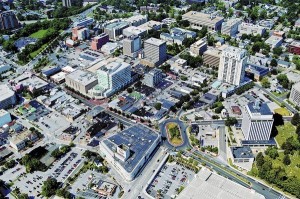On August 1st, the Baltimore County Council is expected to consider my legislation that would establish a Downtown Towson zoning district. The legislation represents the culmination of 18 months of work as we look to shape and improve development standards in our county seat.
would establish a Downtown Towson zoning district. The legislation represents the culmination of 18 months of work as we look to shape and improve development standards in our county seat.
Right now, Downtown Towson is zoned BM-CT, a designation that it shares with other urban areas throughout Baltimore County. But Downtown Towson is different. This is the county seat, a headquarters for law, government, medicine, and higher education that in many other places would have the building standards found in a small city.
Over the years, as developments have been proposed, I found myself proposing bills that amended the BM-CT area only for Towson. For example, we required bike parking in new construction. We constantly had to change parking requirements, since there is an assumption that motorists will use the abundance of parking garages concentrated in Towson. We boosted open space requirements, charging $2,000 per unit if a development does not internalize recreational space for its residents.
The business community complained about the piecemeal approach to development; so did residents and many environmental advocates. For that reason, in the spring of 2015, I required new construction to go through the Baltimore County Design Review Panel, a panel of architects and engineers that evaluates the quality of development.
The legislation now being considered by the County Council establishes metrics for the Design Review Panel. It prioritizes green building standards, connectivity, and good architectural standards, and tackles some issues like lighting where the county may not be as progressive as other jurisdictions.
Much of the debate has been over the words “shall” versus “should” or “may.” In the end, I want a bill to pass that can garner the County Executive’s support and empower the Design Review Panel to make thoughtful improvements to development plans.
I would like to thank the Planning Department and the Planning Board for drafting a proposal that formed the basis for our work. I would like to acknowledge the Greater Towson Committee, which has pushed for a simplification of the building codes for the past several years. But special credit goes to the Green Towson Alliance, an extraordinarily hard working organization that worked with my office on countless drafts of the legislation.

